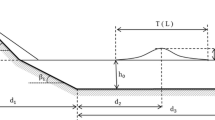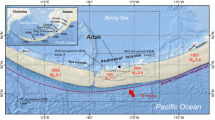Abstract
Tsunami risk reduction activities rely on a sound knowledge of the hazard characteristics. Our understanding of these characteristics is derived from empirical measurements, numerical models or established rules. Conventional methods used to delineate areas vulnerable to tsunami inundation are often calculated from estimated maximum wave height at the coast and “rules-of-thumb”. Applying such rules may give unreliable results for decision-makers. Using basic hydraulic principles and assumptions, this paper improves on the existing rules by developing and testing new equations for predicting tsunami maximum depth profiles and inundation distances. The proposed equations require knowledge of shoreline wave-crest level, the onshore ground profile and an index for onshore roughness (a ratio of distance between protrusions to a local friction factor). As a tsunami wave moves inland, the equations demonstrate that there will usually be an exponential decline in peak water depth. The equations also confirm that a smaller spacing between onshore roughness elements, such as trees or houses, will give a steeper decline in peak depth due to increased friction as a wave moves inland. Furthermore, where ground level is rising faster than friction head is being lost, it is predicted that the water level of a tsunami will rise above the shoreline wave-crest level. The ground slope at which run-up starts to exceed shoreline wave-crest level can be predicted from the shoreline wave-crest level and roughness spacing. Results predicted by the new equations are verified by comparison with tsunami run-up measurements made in Samoa and Java.









Similar content being viewed by others
References
Bretschneider CL, Wybro PG (1977) Tsunami inundation prediction. In: Johnson JW (ed) Proceedings of 15th Coastal Engineering conference. ASCE, Honolulu, pp 1006–1024
Byrant E (2014) Tsunami: the underrated hazard. Springer, London
Camfield FE (1980) Tsunami engineering. In Special Report 6. Coastal Engineering Research Centre, US Army Corps of Engineers
Cavallo A, Ireland V (2014) Preparing for complex interdependent risks: a system of systems approach to building disaster resilience. Int J Disaster Risk Reduct 9:181–193
Choi BH, Pelinovsky E, Hong SJ, Woo SB (2003) Computation of tsunami in the East (Japan) Sea using dynamically interfaced nested model. Pure Appl Geophys 160:1383
Fraser S, Power W, Wang X, Wallace L, Mueller C, Johnston D (2014) Tsunami inundation in Napier, New Zealand, due to local earthquake sources. Nat Hazards 70:415–445
Fritz HM, Kongko W, Moore A, McAdoo B, Goff J, Harbitz C, Uslu B, Kalligeris N, Suteja D, Kalsum K, Titov V, Gusman A, Latief H, Santoso E, Sujoko S, Djulkarnaen D, Sunendar H, Synolakis C (2007) Extreme run-up from the 17 July 2006 Java tsunami. Geophys Res Lett 34:L12602
Gayer G, Leschka S, Nöhren I, Larsen O, Günther H (2010) Tsunami inundation modelling based on detailed roughness maps of densely populated areas. Nat Hazards Earth Syst Sci 10:1679–1687
Giles PT (1998) Geomorphological signatures: classification of aggregated slope unit objects from digital elevation and remote sensing data. Earth Surf Proc Land 23:581–594
Goff J, Dominey-Howes D (2011) The 2009 South Pacific Tsunami. Earth Sci Rev 107:v–vii
Guha-Sapir D, Below R, Hoyois P (2014) EM-DAT: International disaster database Brussels. Université Catholique de Louvain, Belgium
Henderson FM (1966) Open channel flow. Macmillan, New York
Hills JG, Mader CL (1997) Tsunami produced by the impacts of small asteroids. Ann N Y Acad Sci 822:381–394
Houston JR, Garcia AW (1978) Type 16 Flood Insurance Study: tsunami predictions for the West Coast of the continental United States. In: Report Technical (ed) H-78-26. U.S. Army Engineer Waterways Experiment Station, Vicksburg
Imamura F (2009) Tsunami modeling: calculating inundation and hazard maps. In: Bernard EI, Robinson AR (eds) The sea: tsunami. Harvard University Press, London
Ioualalen M, Pelinovsky E, Asavanaunt J, Lipikorn R, Deschamps A (2007) On the weak impact of the 26 December Indian Ocean tsunami on the Bangladesh coast. Nat Hazards Earth Syst Sci 7:141–147
Jaffe BB, Gelfenbaurn G, Buckley ML, Watt S, Apotsos A, Stevens AW, Richmond BM (2010) The limit of inundation of the September 29, 2009, tsunami on Tutuila, American Samoa. In Open-File Report. USGS
Jin D, Lin J (2011) Managing tsunamis through early warning systems: a multidisciplinary approach. Ocean Coast Manag 54:189–199
Leonard GS, Lukovic B, Langridge R, Downes G, Power W, Smith W, Johnston DM (2009) Interim tsunami evacuation planning zone boundary mapping for the Wellington and Horizons regions defined by a GIS-calculated attenuation rule. GNS Science, Wellington
Liu PL-F, Lynett P, Fernando H, Jaffe BE, Fritz H, Higman B, Morton R, Goff J, Synolakis C (2005) Observations by the International Tsunami Survey Team in Sri Lanka. Science 308:1595
Løvholt F, Setiadi NJ, Birkmann J, Harbitz CB, Bach C, Fernando N, Kaiser G, Nadim F (2014) Tsunami risk reduction—are we better prepared today than in 2004? Int J Disaster Risk Reduct Part A 10:127–142
McSaveney M, Rattenbury M (2000) Tsunami impact in Hawke’s Bay. In Client Report 2000/77. Institute of Geological and Nuclear Sciences
Okal EA, Fritz HM, Synolakis CE, Borrero JC, Weiss R, Lynett PJ, Titov VV, Foteinis S, Jaffe BE, Liu PL-F, Chan I-C (2010) Field survey of the Samoa tsunami of 29 September 2009. Seismol Res Lett 81:577–591
Power W (2013) Review of Tsunami Hazard in New Zealand. GNS Science, Wellington
Reese S, Cousins WJ, Power WL, Palmer NG, Tejakusuma IG, Nugrahadi S (2007) Tsunami vulnerability of buildings and people in South Java–field observations after the July 2006 Java tsunami. Nat Hazards Earth Syst Sci 7:573–589
Reese S, Bradley BA, Bind J, Smart G, Power W, Sturman J (2011) Empirical building fragilities from observed damage in the 2009 South Pacific tsunami. Earth Sci Rev 107:156–173
Sato H, Murakami H, Kozuki Y, Yamamoto N (2003) Study on a simplified method of tsunami risk assessment. Nat Hazards 29:325–340
Saunders WSA, Baban JG, Coomer MA (2014) Assessment of council capability and capacity for managing natural hazards through land use planning. In: Science GNS (ed) Report. GNS Science, Wellington
Scheer SJ, Varela V, Eftychidis G (2012) A generic framework for tsunami evacuation planning. Phys Chem Earth Parts A/B/C 49:79–91
Schuiling RD, Cathcart RB, Badescu V, Isvoranu D, Pelinovsky E (2007) Asteroid impact in the Black Sea. Death by drowning or asphyxiation 40:327–338
Taubenböck H, Goseberg N, Setiadi N (2009) “Last-Mile” preparation for a potential disaster. Interdisciplinary approach towards Tsunami early warning and an evacuation information system for the coastal city of Padang, Indonesia. Nat Hazards Earth Syst Sci 9:1509–1528
Titov VV, Synolakis CE (1998) Numerical modeling of tidal wave run-up. J Waterway Port Coastal Ocean Eng 124:157–171
Vogel C, Moser SC, Kasperson RE, Dabelko GD (2007) Linking vulnerability, adaptation, and resilience science to practice: pathways, players, and partnerships. Glob Environ Change 17:349–364
Wegscheider S, Post J, Zosseder K, Mück M, Strunz G, Riedlinger T, Muhari A, Anwar HZ (2011) Generating tsunami risk knowledge at community level as a base for planning and implementation of risk reduction strategies. Nat Hazards Earth Syst Sci 11:249–258
Wood N, Jones J, Schelling J, Schmidtlein M (2014) Tsunami vertical-evacuation planning in the U.S. Pacific Northwest as a geospatial, multi-criteria decision problem. Int J Disaster Risk Reduct 9:68–83
Acknowledgments
Financial support for this research was provided by core funding from the NZ National Institute of Water and Atmospheric Research (NIWA) under the RiskScape project www.riskscape.org. The work is supported by the NZ Ministry of Business, Innovation and Employment, Natural Hazards Research Management Platform.
Author information
Authors and Affiliations
Corresponding author
Electronic supplementary material
Below is the link to the electronic supplementary material.
Rights and permissions
About this article
Cite this article
Smart, G.M., Crowley, K.H.M. & Lane, E.M. Estimating tsunami run-up. Nat Hazards 80, 1933–1947 (2016). https://doi.org/10.1007/s11069-015-2052-8
Received:
Accepted:
Published:
Issue Date:
DOI: https://doi.org/10.1007/s11069-015-2052-8




